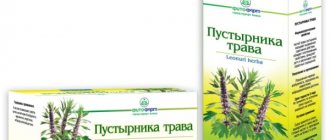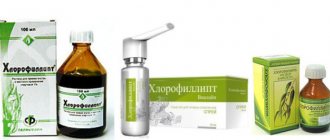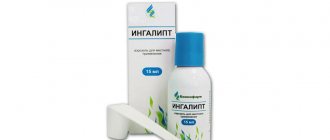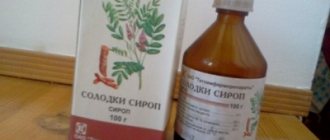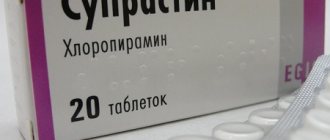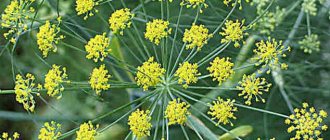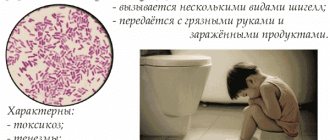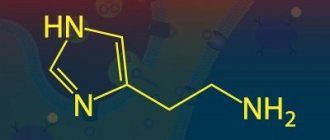Sulfacyl sodium in the nose
Sulfacyl sodium drops, also known as Albucid, are sometimes prescribed by doctors into the nose, despite the fact that these are eye drops.
They have a pronounced antibacterial effect, which, in addition to killing bacteria, relieves inflammation.
In ophthalmology, they are intended for the treatment of purulent ulcers, blepharitis, conjunctivitis, blenorrhea and other diseases caused by streptococci, pneumococci and gonococci. Since this medication is intended for the delicate tissue of the eye, it naturally cannot harm the nasal mucosa, and therefore doctors sometimes prescribe it to treat a runny nose caused by bacteria sensitive to the main active ingredient.
Sulfacyl Sodium in the nose - instructions
The prescription of Sulfacyl sodium nasal drops must be confirmed by a doctor in order to avoid incorrect treatment and complications.
Sulfacyl sodium - indications for use
The classic instructions indicate that these drops are used in the eyes for inflammatory infectious lesions. When it comes to using sodium sulfacyl for the nose, the main indication here is also inflammation due to a bacterial infection.
It is not easy to distinguish a viral runny nose from a bacterial one - sometimes a viral infection can transform into a bacterial one with a long illness and weak immunity, and therefore you should not assume that the onset of a viral illness is a guarantee of the absence of a bacterial one.
In case of bacterial infection of the nose, the main symptom and indication for the use of Sulfacyl sodium is nasal congestion - runny nose, swelling of the mucous membrane. When there is a virus, nasal discharge is clear in color, and when a bacterial infection occurs, the mucus has a greenish and yellowish tint. The color of the discharge can accurately indicate the nature of the infection.
Application of Sulfacyl sodium
Sulfacyl sodium for a runny nose is sometimes prescribed to young children, since they do not have the vasoconstrictor effect that almost all modern drops have for the treatment of a runny nose - viral, allergic and bacterial etiology. Many believe that the vasoconstrictor effect is significantly harmful to health and is addictive, which is undesirable especially in childhood.
Another reason why a doctor may prescribe sodium sulfacyl for the nose is the low cost of the medication. In modern pharmacology, there are quite a lot of medications that are unreasonably overpriced in the presence of inexpensive analogues. Pharmaceutical companies thus receive money for brand promotion and beautiful packaging design.
Doctors prescribe sodium sulfacyl 20% drops into the nose. This is the ideal concentration to destroy bacteria without harming the body.
It should also be noted that sodium sulfacil is stored for no longer than 7 days after opening the bottle.
How many days do you need to drip Sulfacyl sodium?
The duration of treatment of a runny nose with Sulfacyl sodium drops depends on the severity of the disease and the effect they have on recovery. In the classic example, sodium sulfacyl is used 2 drops in each nostril 3 times a day for 7 days. It is advisable to clean and rinse your nose with warm water before use.
But the duration of treatment should be prescribed by the doctor individually - if the drops are ineffective, replace them with another antibacterial agent with a different active ingredient, or prescribe an extension of treatment with these drops.
Sulfacyl sodium - contraindications
Sulfacyl sodium drops have a minimum of contraindications - individual intolerance to the drug, as well as pregnancy and lactation. Some doctors believe that these drops can be used during pregnancy and breastfeeding.
WomanAdvice.ru>
Albucid composition
A sustainable therapeutic effect is ensured due to the peculiarities of the chemical composition of Albucid drops. The active component, sodium sulfacyl for the nose, acts locally, so the risk of side effects and the list of contraindications is minimal. The active substance does not penetrate the systemic bloodstream, its concentration is insufficient for a sharp deterioration in health or the appearance of allergies. The main effect is a violation of the integrity of the pathogenic flora, its accelerated removal from the infected nasal passages.
In fact, this is an antibacterial drug for the nose, which is allowed to be used in childhood when daily dosages are specified. If necessary, there are analogues, but no one doubts the therapeutic effect of Albucid. Eye drops for a runny nose have a vasoconstrictor effect, in addition, there are several names of medications that are equally allowed to be instilled into the nose and eyes. The auxiliary components are hydrochloric acid, sodium thio sulfate and water.
Albucid in the nose: when can you use the product?
The drug "Albucid" is known to many parents as an antibacterial eye drug. However, the range of use of drops has recently expanded significantly, and now many doctors recommend dripping Albucid into the nose of children and adults for a runny nose.
How the drug works
Albucid eye drops, in which the active ingredient is sodium sulfacyl, effectively fights infectious eye diseases. It is used in ophthalmology as an antibacterial agent aimed at temporarily suppressing the vital activity of pathogenic microorganisms and their ability to reproduce.
Albucid for a runny nose is effective against the following microorganisms:
- gram-positive flora and gram-negative bacteria;
- actinomycetes;
- chlamydia;
- Escherichia;
- pathogenic cocci.
The product is intended for the treatment of bacterial conjunctivitis, blepharitis, purulent ulcers on the cornea and gonorrheal eye diseases. Drops are also prescribed as a prophylactic against blenorrhea in newborns. Albucid drops in the nose and eyes are contraindicated in case of intolerance to sulfonamides. Sometimes the use of a medicine can cause side effects such as redness, itching, swelling and burning of the eyes or skin; in such cases, you should stop using it .
There are drops for children and for adults, the difference between the drugs is the concentration of sodium sulfacyl. Due to the fact that one dose is relatively small, and the absorption of the drug into the blood is very minimal, the medicine can be used to treat rhinitis in newborns.
When is it advisable to use drops?
If a runny nose appears as a result of a virus entering the body, this antibacterial drug is not prescribed. The indication for use of the drug is a prolonged runny nose, which is accompanied by a bacterial infection. Bacterial runny nose can be recognized by the following signs:
- protracted course of the pathological process;
- thick discharge from the nasal cavity, sometimes it can have a foul odor;
- green or yellow-green color of mucus secreted;
- ineffectiveness of conventional anti-rhinitis medications.
Often, the use of Albucid for a runny nose in children is more effective than the use of antibacterial drops. This happens due to the fact that antibiotics are effective against one group of bacteria that may be resistant to the active substance of the selected drug . At that time, Albucid has a detrimental effect on all bacteria, especially if the runny nose is caused by the penetration of staphylococci, streptococci, Escherichia and chlamydia. Many parents choose these drops because they are very cheap compared to modern antibacterial drugs.
Application of drops: user reviews
Albucid for a runny nose has found both its supporters and opponents. You can read reviews about the dangers of the drug, since with long-term use it has a vasoconstrictor effect. However, experts refute this statement, since it has long been proven that the drug has absolutely no effect on blood vessels.
Some people write in reviews of Albucid that it is completely powerless against the runny nose. First of all, the effectiveness of the antibacterial agent depends on the etiology of the runny nose. You should know that if you have allergic rhinitis, sodium sulfacyl will not relieve you of the disease, since the signs of allergy can only be eliminated with antihistamines. Albucid for a runny nose will improve a person’s condition only if the pathological process is caused by bacteria.
Before use, infants should dilute Albucid 1:1
The disadvantage of this treatment is a burning sensation in the nose, which occurs immediately after instillation of the medicine. This side effect is especially intense in children, since their mucous membrane is still too sensitive. Albucid irritates the mucous membrane, but at the same time it dries it out and reduces the amount of mucus produced. When deciding to undergo treatment with this drug, the main thing is to comply with the permissible dosage. It is enough to drop 1-2 drops into each nasal passage. If infants are being treated, before instilling the product, it must first be diluted with water 1:1. For newborn babies, it is better to treat the nasal passages with a cotton swab dipped in a solution of sodium sulfacyl.
Some patients are interested in what color the mucus should be so that the remedy can be used. Green discharge indicates the bacterial origin of a runny nose, so it is precisely with this sign that Albucid should be dripped into the nose of children and adults. Before instilling this antibacterial agent into the nose, you should consult a doctor to determine the origin of the runny nose. This precaution should be especially taken when treating rhinitis in children.
NasmorkuNet.ru>
In what cases does it make sense to use the drug?
Theoretically, the administration of a substance is justified only when mucus was collected from the nose of a sick child for analysis, after which it was determined that the causative agent of the runny nose is sensitive to sodium sulfacyl.
As a rule, such an analysis is carried out within a few days (3-4), and during this time, in most cases, the disease goes away on its own and no longer requires any medications.
When prescribing the drug to children without conducting a study of nasal discharge, the pediatrician is acting at random, and parents should remember this.
Often this drug is prescribed for runny noses in children simply because something needs to be prescribed since the child has been brought in for an appointment. And if the doctor sees that the culmination of the disease has already passed and the baby does not need medication, that everything will go away on its own in 2-3 days, he usually prescribes Albucid, first of all, to reassure the parents.
With short-term use, the product will not cause harm, will not cause side effects or an allergic reaction, but will not bring any benefit. The child’s body will cope with the disease on its own, but the parents will be sure that this particular drug helped.
If parents nevertheless decide to drop this product into the child’s nose, it should be noted that for a one-time complete treatment of the inflamed mucous membrane, approximately one bottle will be required, but this will not be possible, since the substance will flow into the larynx.
Therefore, you can instill the product like regular nasal drops, after thoroughly blowing your nose, introducing 1-2 drops into each passage, repeating the procedure about 3 times a day. Young children who do not yet know how to blow their nose need to clean their nose with a special aspirator.
Infants are not allowed to use such drops. Read more about how and what to treat a runny nose in newborns →
How to use sodium sulfacyl for a runny nose
Sometimes doctors recommend Albucid (Sodium Sulfacyl) to treat a runny nose. Traditionally, these drops are used as eye drops, so many patients are completely at a loss. Was there an error when prescribing the medicine, and are these drops really used for a runny nose?
How do the drops work?
"Albucid" is a fairly common sulfonamide drug. It is made on the basis of sodium sulfacyl, which is contained in the drug at a concentration of 20 or 30%. Having an antimicrobial effect, this medicine prevents the growth and reproduction of bacteria, which helps the body fight off infection.
“Albucid” is especially effective for runny nose caused by staphylococci, streptococci, Escherichia and chlamydia. This remedy is usually used as eye drops for the treatment or prevention of inflammatory diseases. None of the instructions for the drug say that it can be used for a runny nose, but doctors often make such prescriptions, especially for children. To find out for sure whether Albucid will help in treating a runny nose, it is necessary to conduct a laboratory test of the discharge.
In what cases is sodium sulfacyl used for a runny nose?
This remedy can be used to treat a nasal disease if there are no other drops at hand, and a runny nose causes a lot of trouble. To achieve maximum effect, you need to use the drug correctly, or rather in those situations where it is really indicated.
With a runny nose that has just begun, the drug will be useless at best. The source of infection has not yet spread to the nasal sinuses, so the use of Albucid will not destroy the pathogen. The drops will be especially effective for prolonged and purulent runny nose, in which green discharge with an unpleasant odor is observed. In this case, the remedy can have an excellent therapeutic effect. The active ingredient "Sodium Sulfacyl" may be an allergen for the patient, so the drug should be used with caution.
How to use Sulfacyl sodium
This medicine is instilled 2-3 drops three times a day until signs of a runny nose completely cease. It has no contraindications, with the exception of the individual sensitivity of the body. When treating children, the irritating effect of the drug should be taken into account, strictly observing the dosage. Before administering the drug to babies, it must be diluted with boiled water in a 1:1 ratio.
According to numerous reviews, the old and proven “Sodium Sulfacyl” is still popular. This product is easily accessible and can be used in the absence of qualified medical care, so it is indispensable for a home, country and vacation first aid kit. But before using it in children, you should consult a doctor.
KakProsto.ru>
Is it possible to use Albucid drops in the nose of children? At what age is the drug prescribed?
In order to answer the question of whether it is possible to instill Albucid into the nose of children, it is necessary to determine what this drug is and what it is prescribed for. The medicine is available in the form of drops for both children and adults, differing only in the percentage of active substance content - sodium sulfacyl, or sulfacetamide. The main action of the component is aimed at eliminating bacteria such as streptococci, gonococci, E. coli, staphylococci, chlamydia, etc. Since a single dose of the substance is quite small, and the level of its absorption into the blood is quite low, “Albucid” can be instilled into the nose of children with almost no restrictions . It should be noted that newborns are prescribed the drug from the first minute of life to prevent eye diseases.
Effect of the drug
Albucid drops are an antimicrobial agent, the action of which is aimed at destroying the process of building amino acids in bacterial cells. As a result, the proliferation of pathogenic microorganisms stops. This drug has a wide range of effects, so it is often prescribed for various infections of the upper respiratory system.
For what kind of runny nose are these drops prescribed?
It should be noted that this medicine is not suitable for all cases of rhinitis. The drug "Albucid" in the nose is prescribed to children only when the runny nose is of a bacterial nature. At the early stage of the disease, mucous discharge from the nasal cavity is observed, which is often provoked by viruses, so prescribing the drug in this case is inappropriate and useless. The indication for the use of Albucid drops is a prolonged runny nose, which is accompanied by a bacterial infection.
Signs of a bacterial runny nose
- protracted course;
- the presence of thick, sometimes foul-smelling discharge from the nasal cavity;
- greenish-yellow or green color of discharge;
- unsuccessful treatment of rhinitis with conventional medications.
In some cases, Albucid drops for children are more effective than other antibiotics. This is because the antimicrobial substances contained in nasal drops are often able to affect only a certain type of bacteria. When exposed to an insensitive pathogen, such an antibiotic, as a rule, does not work. Therefore, in order to find out whether Albucid can be given to a child, it is necessary to determine the exact cause of the runny nose, otherwise all treatment will be in vain.
Indications
The drug is mainly prescribed for the treatment of eye diseases such as blepharitis and conjunctivitis. It also eliminates various purulent lesions. Pediatricians often prescribe Albucid drops into the nose of children with a bacterial infection of the upper respiratory system.
For allergic rhinitis, the drug does not have a therapeutic effect. Therefore, before using this medicine, especially for young children, you should make sure that nasal discharge is not caused by the body’s reaction to teething. Infection of the nose is accompanied by greenish discharge, while allergies are characterized by clear and light-colored nasal discharge.
Contraindications
Albucid drops, the use of which is safe even for newborns, still have some contraindications. The main one is the body’s increased sensitivity to drugs from the sulfonamide group. In addition, it is not recommended to use this medicine in case of renal failure, or to take it simultaneously with medications containing silver.
The drug "Albucid" for children (the instructions describe in detail all the properties and effectiveness of this medication) is an indispensable assistant for many young mothers, since it is quite simple to use.
Use of the medicine
To treat bacterial rhinitis, the drug “Albucid” should be instilled into each nostril, after first cleaning the mucous membrane by rinsing with saline and then blowing off the mucus. If necessary, use an aspirator.
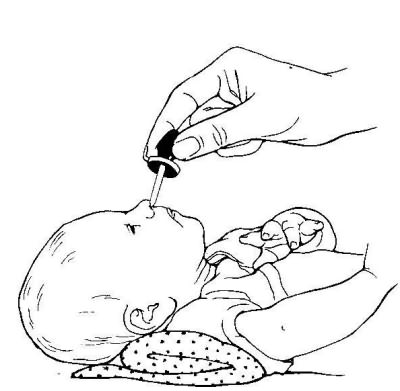
It should be noted that this medicine can have an irritating effect, so the dosage must be strictly observed. Before burying the baby's nose, it is recommended to dilute the solution with boiled water 1:1 to reduce the concentration of the active substance. No more than two drops of the drug should be installed in each nostril three times a day.
If during the procedure the baby behaves restlessly and is constantly fidgeting, you can gently wipe his nose with a cotton swab dipped in water, while slightly tilting his head back. It has been noticed that the drug has a drying effect on the nasal mucosa, thereby reducing the amount of secretions. Sometimes a child may react sharply to the administration of a medicine, which is explained by a burning sensation, so mothers should not worry too much about this. By using drops, you ensure that the active substance reaches the very epicenter of the accumulation of microbes, thereby protecting your child from taking antibacterial agents internally.
Only a pediatrician can decide whether to use the drug “Albucid” or not, so at the first symptoms of a runny nose in your baby, be sure to consult a specialist. Modern pharmaceuticals are constantly creating and developing new drugs that can be more effective and act faster on the causative agent of the disease, so the help of a doctor will not be superfluous here.
fb.ru>
Is it possible to put eye drops into the nose, how do they work?
The instructions for these eye drops do not describe the nasal method of using the medicine. However, it is effective not only in ophthalmology. Is it possible to drip Albucid into a child’s nose? Experienced doctors say that its use is justified.
Often this remedy helps get rid of unpleasant symptoms that cannot be treated with antibiotic drops. The reason is a very wide range of flora that are sensitive to its action, while most antibiotics kill only certain groups of bacteria.
Simultaneously with the destruction of pathogenic flora, Albucid relieves swelling of the mucous membranes and nasopharyngeal tonsils, promotes the narrowing of lymphoid tissue, and restores the acidic environment. It really heals, and does not just drive away unpleasant sensations.
The drug acts only at the injection site. The extent of its distribution in the body is very small. For the nose, use a product containing 20% active substance. The process of instilling Albucid does not cause discomfort; most children tolerate its use well. The youngest patients may feel a slight burning sensation, but the discomfort disappears within the first five minutes after instillation.
